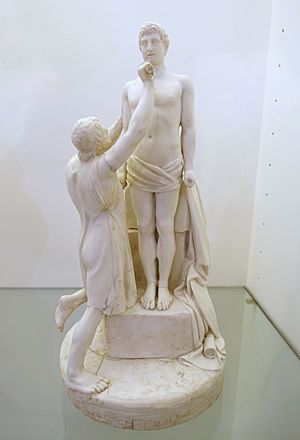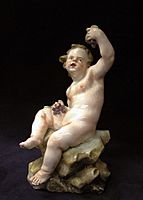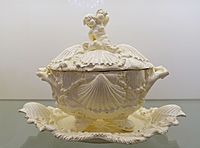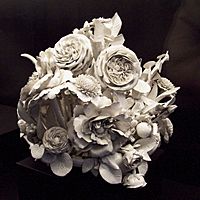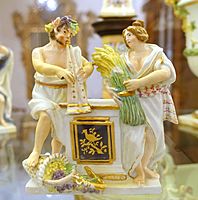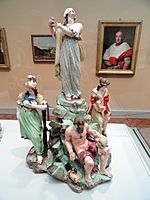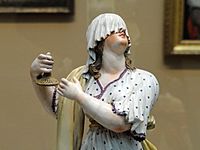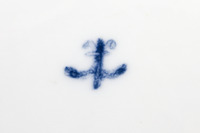Real Fábrica del Buen Retiro facts for kids
The Royal Buen Retiro Porcelain Factory (also known as La China) was a famous factory in Spain. It made beautiful porcelain items. The factory was located in Madrid, inside the Parque del Buen Retiro, Madrid, near a fountain called Fuente del Ángel Caído.
This factory started in 1760. It was created by moving the Capodimonte porcelain factory from Naples. This happened because Carlos III of Spain, who founded the Naples factory, became the King of Spain. He brought the factory's tools, about 40 important workers, and almost five tons of special porcelain clay with him. One of the key artists was Giuseppe Gricci, who designed many pieces. Because both factories used the same clay, artists, and a special flower symbol (fleur-de-lys), it can be hard to tell their early products apart. The factory first made soft porcelain. In 1803, it switched to making hard porcelain. They also made some creamware, which is a type of fine earthenware from England.
The factory mostly made small statues, especially of characters from old stories. But they also created dishes for tables and fancy items like vases. They even decorated special "porcelain rooms" in three royal palaces. At first, Gricci's designs were fancy and curved, like the Rococo style. But soon, a newer, simpler style called Neoclassicism became popular. This style stayed important for the rest of the factory's life.
After a difficult time during the Napoleonic Wars, the factory moved in 1817. It became the Royal Factory of La Moncloa in a different part of Madrid. They took the molds, equipment, and workers that were left. This new factory continued to operate until 1849.
Contents
Royal Porcelain Rooms

Giuseppe Gricci had already made a special porcelain room in a Chinese style at the Palace of Portici near Naples. This room is now at the Palace of Capodimonte. Soon, he was asked to make another one at the Palace of Aranjuez. He built and installed it between 1763 and 1765. This room cost a lot of money!
The factory made another, smaller porcelain room for the main Palacio Real, Madrid. This one was in the newer Neoclassical style. Carlo Schepers designed it in the 1770s. Both of these rooms had walls mostly covered with plain white porcelain tiles. Over these tiles, there was a network of colorful designs. These designs were raised, showing plants and figures.
A porcelain room at the small Casita del Principe, El Escorial looked very different. It was also Neoclassical. Its walls were almost completely covered by 234 special tiles. These tiles looked like Wedgwood's jasperware. They had a "Wedgwood blue" background with white designs. The designs were made of biscuit porcelain and were slightly raised. These white designs were made separately and then stuck onto the blue tiles before firing. The tiles were framed like paintings. They were made between 1790 and 1795.
Factory History
The 1700s
The factory started in 1760. It was built in the Buen Retiro park, which was then the private garden of a royal palace. Carlos III of Spain decided to create it. He became King of Spain in 1759. His wife, Maria Amalia of Saxony, was also very important to the factory.
Before becoming King of Spain, Charles was King of Naples and Sicily. He and his wife had already started a similar factory there, called the Porcellana di Capodimonte. Maria Amalia died in 1760, shortly after moving to Madrid. But she greatly influenced both the Naples and Madrid factories.
Fifty-three skilled Italian craftspeople came from Naples to Madrid. They brought three shipments of tools and special clay. Their goal was to build a factory to make royal porcelain in Madrid. Gaetano Schepers was in charge. Ten Spanish artists also worked there. The quality of the porcelain was known worldwide. The way they made it was a secret kept by the government. Buen Retiro porcelain was part of Spain's plan to boost trade and wealth during the Age of Enlightenment. Other factories in Madrid made luxury items like tapestries and glass.
The 1800s
In 1803, the factory's leadership changed. Bartolome Sureda y Miserol, a Spanish director, took over from the Italian board. Sureda managed several royal factories during his career. These included the Real Fábrica de Paños de Brihuega in Guadalajara and the Real Fábrica de Cristales de La Granja. He also directed the Royal Factory of La Moncloa.
In 1812, during the Peninsular War, French forces were pushed out of Madrid. The park where the factory stood became a battlefield. The French used the factory building as a fort. The British army attacked it. Wellington, the British commander, ordered the building to be burned. The factory stopped making porcelain. Some people think the factory was destroyed not just for war reasons, but also because of business competition.
In 1817, the factory was started again in a new location in Madrid. It became the Royal Factory of La Moncloa. Ferdinand VII moved the workshops and storage from Buen Retiro to La Moncloa. Sureda became the director again in 1821. All the workers from the old factory were hired at the new one.
Where to See the Porcelain
Besides the special porcelain rooms, you can see a great collection of porcelain from the factory at the Museo de Historia de Madrid. The Museo Nacional de Artes Decorativas also has some pieces on display. You can find a few items in the Museo del Prado. Many other museums in Europe and America also show pieces from the factory.
Gallery
-
Pan and Ceres, made between 1790 and 1795.
-
The early factory mark, a fleur-de-lys (upside down, from the writing set).
Images for kids
-
Porcelain room in the Palace of Aranjuez, by Gricci, 1763-1765
-
The factory in the Buen Retiro Park, in the center, beyond the lake.
See also
 In Spanish: Real Fábrica de Porcelana del Buen Retiro para niños
In Spanish: Real Fábrica de Porcelana del Buen Retiro para niños
- Real Fábrica de Cristales de La Granja
- Royal Tapestry Factory


